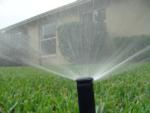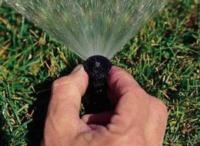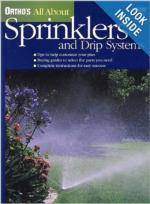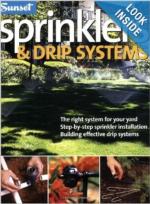Sprinkler Irrigation
Rain Birds Irrigation Glossary- Learn the terms 
UC - Lawn Irrigation Scheduling
UC - Sprinkler Irrigation Can Test - Estimate your sprinkler output using the "can test"
Can test Water Use it Wisely - guide on lawn irrigations that includes a can test with an interactive calculation system for your measurements and a printable guide.
Irrigate Efficiently - This website provides advice on how to water your yard to optimize plant health and minimize waste. (California Urban Water Conservation Council)
Improving an existing irrigation system - If you already have a sprinkler system, it's easy to convert it to a drip irrigation system. You simply use the existing supply lines and replace some of the sprinkler heads with drip irrigation supply heads. Here are some online resources that can help you learn how to convert your existing system to a water-efficient drip irrigation system.
Video How-To Help
- Toro: Upgrade with smart irrigation solutions
- Toro’s Guide to Smart Irrigation
- Rain Bird's All About Automatic Sprinkler Systems
Installing a new sprinkler system - For an irrigation system to be successful, it must include proper design, correct installation, the right component selection, the proper layout, and equally important, appropriate maintenance.
Manuals and More - Includes manuals for controllers, sprinklers and valves.
Springtime Sprinkler Tune-Up Checklist - Sprinkler system tune-up tips from Rain Bird to help you save water, time and money in your yard
Irrigation System Maintenance
(Irrigation Association)


Irrigation systems need regular maintenance to keep them working efficiently year after year. Damage from lawn equipment or improper winterization can cause leaks and other serious problems.
- Inspect your system monthly. Check for leaks, broken or clogged sprinkler heads, and other problems. Clean clogged screens and micro-irrigation filters as needed.
- Adjust sprinkler heads. Remove or correct obstructions that prevent sprinklers from distributing water evenly. Adjust sprinkler head positions and spray patterns to avoid watering sidewalks or structures and to provide necessary clearance over growing plants.
- Check the pressure. Pressure can change over time and negatively affect system efficiency.
- Inspect the system for leaks. Leaks are a huge water waster. A good contractor can perform regular maintenance checks for leaks, broken or clogged spray heads, and other problems. Ask them to show you common problems to watch for between visits.
- Install a rain shutoff switch. These inexpensive sensors can be retrofitted to almost any system and help compensate for natural rainfall by turning off your system in rainy weather.
- Consider “smart” technology. Climate or soil moisture sensor-based controllers evaluate weather or soil moisture conditions and then automatically adjust the irrigation schedule to meet the specific needs of your landscape.
- Consider low volume, micro-irrigation for gardens, trees and shrubs. Drip (or trickle) irrigation, micro spray jets, micro-sprinklers and bubbler irrigation all apply a very small amount of water, slowly and precisely, minimizing evaporation, runoff and overspray.
- Have your system audited. Hire a professional to conduct an irrigation audit and uniformity test to verify areas are being watered evenly and appropriately, and make necessary adjustments.
- Look for savings. Many water utilities offer rebates for certain water-efficient products. Before upgrading your new system, consult with your local water provider.
- Winterize in colder climates. An irrigation contractor with specialized equipment will flush out water that could freeze and crack pipes, valves and sprinklers.


